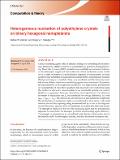Heterogeneous nucleation of polyethylene crystals on binary hexagonal nanoplatelets
Author(s)
Volchko, Nathan W.; Rutledge, Gregory C.
Download10853_2024_Article_9683.pdf (3.584Mb)
Publisher with Creative Commons License
Publisher with Creative Commons License
Creative Commons Attribution
Terms of use
Metadata
Show full item recordAbstract
Crystal nucleating agents offer an effective strategy for controlling the morphology, dimensional stability and rate of solidification of polymers during processing. Molecular dynamics (MD) simulation can shed light on nucleation behavior at the nanoscopic length and time scales over which nucleation occurs. In this work, crystal nucleation of a polyethylene oligomer, n-pentacontane, on three graphene-like substrates, hexagonal boron nitride (hBN), molybdenum disulfide (MoS2), and tungsten disulfide (WS2), was simulated, and the thermodynamic efficiencies of these substrates as nucleating agents were determined. Experimental measurements of heterogeneous nucleation of a high-density polyethylene on nanoparticles of these three graphene-like materials were performed using the method of dispersed microdroplets in an immiscible polystyrene matrix. Qualitative agreement between simulations and experiments was observed for trends in nucleation rate, J, and interfacial free energy difference, Δσ, with
$$J_{\text{hBN}} > J_{\text{MoS}_{2}} > J_{\text{WS}_{2}}$$
J
hBN
>
J
MoS
2
>
J
WS
2
. The simulations are then used to gain additional insight into the mechanisms of nucleation. Epitaxy is confirmed in all systems, with small mismatches in lattice spacing being accommodated by strain in the oligomer crystal. However, epitaxy alone is insufficient to explain the observed trends. The strength of interaction between the nucleating agent and the polyethylene oligomer is found to be the strongest predictor of nucleating agent efficiency. The strength of interaction is in turn related to the density of interaction sites at the interface: hBN has the highest density, and thus the fastest nucleation rate.
Date issued
2024-05-19Department
Massachusetts Institute of Technology. Department of Chemical EngineeringJournal
Journal of Materials Science
Publisher
Springer Science and Business Media LLC
Citation
Volchko, N.W., Rutledge, G.C. Heterogeneous nucleation of polyethylene crystals on binary hexagonal nanoplatelets. J Mater Sci (2024).
Version: Final published version
ISSN
0022-2461
1573-4803